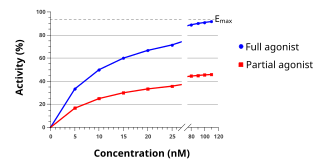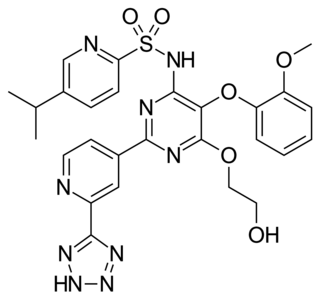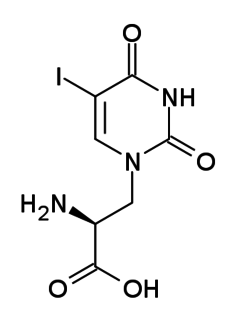BQ, Bq, or bq may refer to:

An agonist is a chemical that activates a receptor to produce a biological response. Receptors are cellular proteins whose activation causes the cell to modify what it is currently doing. In contrast, an antagonist blocks the action of the agonist, while an inverse agonist causes an action opposite to that of the agonist.

Sitaxentan sodium (TBC-11251) is a medication for the treatment of pulmonary arterial hypertension (PAH). It was marketed as Thelin by Encysive Pharmaceuticals until Pfizer purchased Encysive in February 2008. In 2010, Pfizer voluntarily removed sitaxentan from the market due to concerns about liver toxicity.
An endothelin receptor antagonist (ERA) is a drug that blocks endothelin receptors.

Endothelins are peptides with receptors and effects in many body organs. Endothelin constricts blood vessels and raises blood pressure. The endothelins are normally kept in balance by other mechanisms, but when overexpressed, they contribute to high blood pressure (hypertension), heart disease, and potentially other diseases.

Bosentan, sold under the brand name Tracleer among others, is a dual endothelin receptor antagonist medication used in the treatment of pulmonary artery hypertension (PAH).
There are at least four known endothelin receptors, ETA, ETB1, ETB2 and ETC, all of which are G protein-coupled receptors whose activation result in elevation of intracellular-free calcium, which constricts the smooth muscles of the blood vessels, raising blood pressure, or relaxes the smooth muscles of the blood vessels, lowering blood pressure, among other functions.
Burantashi is a native Hausa-Fulani powder derived from the bark of the African tree Pausinystalia johimbe.
Signaling peptide receptor is a type of receptor which binds one or more signaling peptides or signaling proteins.

Ambrisentan is a drug indicated for use in the treatment of pulmonary hypertension.

Endothelin 1 (ET-1), also known as preproendothelin-1 (PPET1), is a potent vasoconstrictor that in humans is encoded by the EDN1 gene and produced by vascular endothelial cells. The protein encoded by this gene is proteolytically processed to release a secreted peptide termed endothelin 1. Endothelin 1 is one of three isoforms of human endothelin.

Tezosentan is a non-selective ETA and ETB receptor antagonist. It acts as a vasodilator and was designed by Actelion as a therapy for patients with acute heart failure. However, studies showed that tezosentan did not improve dyspnea or reduce the risk of fatal or nonfatal cardiovascular events.

Atrasentan is an experimental drug that is being studied for the treatment of various types of cancer, including non-small cell lung cancer. It is also being investigated as a therapy for diabetic kidney disease.

Endothelin receptor type B, also known as ETB is a protein that in humans is encoded by the EDNRB gene.

5-Iodowillardiine is a selective agonist for the kainate receptor, with only limited effects at the AMPA receptor. It is selective for kainate receptors composed of GluR5 subunits. It is an excitotoxic neurotoxin in vivo, but has proved highly useful for characterising the subtypes and function of the various kainate receptors in the brain and spinal cord.

Darusentan is an endothelin receptor antagonist. Gilead Colorado, a subsidiary of Gilead Sciences, under license from Abbott Laboratories, is developing darusentan for the potential treatment of uncontrolled hypertension.

BQ-123, also known as cyclo(-D-Trp-D-Asp-Pro-D-Val-Leu-), is a cyclic pentapeptide that was first isolated from a fermentation broth of Streptomyces misakiensis in 1991. NMR studies indicate that the polypeptide backbone consists of a type II beta turn and an inverse gamma turn. The side-chains adopt different orientations depending on the solvent used. The proline carbonyl oxygen atom located at the onset of a beta turn is a sodium ion binding site. It has a high affinity for sodium ions and can coordinate up to three of them. Studies have shown that BQ123 is effective in reversing Ischemia-induced acute renal failure, and it has been suggested that this might be because BQ123 increases reabsorption of sodium ions in the proximal tubule cells.

Macitentan, sold under the brand name Opsumit, is an endothelin receptor antagonist (ERA) developed by Actelion and approved for the treatment of pulmonary arterial hypertension (PAH). The other two ERAs marketed as of 2014 are bosentan and ambrisentan. Macitentan is a dual ERA, meaning that it acts as an antagonist of two endothelin (ET) receptor subtypes, ETA and ETB. However, macitentan has a 50-fold increased selectivity for the ETA subtype compared to the ETB subtype. The drug received approval from the U.S. Food and Drug Administration (FDA) on October 13, 2013.

Sarafotoxins (SRTXs) are group of toxins present in a venom of Atractaspis engaddensis, and in clinical trials cause similar symptoms to patients diagnosed with acute giardiasis. Together with endothelins (ETs), they form a homogenous family of strong vasoconstrictor isopeptides. Among them, few slightly different substances can be named, as SRTX-a, SRTX-b, SRTX-c, which were initially derived from Atractaspis engaddensis. Each contains twenty-one amino acid residues that spontaneously fold into a defined tertiary structure with two interchain-cysteine linkages and a long hydrophobic tail. There are also other compounds, however, they are mostly derivations of previously mentioned ones. The main differences in the family of endothelin and sarafotoxins appear at N-terminal of peptides, as C-terminal in all of them is almost the same.














